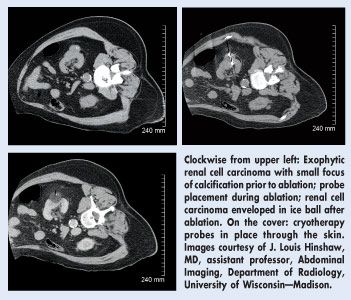For Renal Cryo, Percutaneous Approach Has Advantages
In appropriately selected patients, cryoablation of renal cancers results in equal efficacy, shorter hospital stays for patients, and lower costs when performed percutaneously instead of laparoscopically
SEATTLEIn appropriately selected patients, cryoablation of renal cancers results in equal efficacy, shorter hospital stays for patients, and lower costs when performed percutaneously instead of laparoscopically, finds a retrospective study reported at the 32nd Annual Meeting of the Society of Interventional Radiology (abstract 389). J. Louis Hinshaw, MD, of the University of Wisconsin-Madison, presented the study results at a poster session.
The investigators documented outcomes in all patients treated at the University of Wisconsin Hospital and Clinics for single renal tumors with either percutaneous renal cryoablation, in which cryoprobes are inserted under CT or ultrasound imaging (see Figure), or laparoscopic renal cryoablation.
Outcomes were compared between 24 patients treated percutaneously and 55 treated laparoscopically; the choice between procedures had been based on tumor location (with the percutaneous approach favored for posterior and exophytic locations), proximity of the tumor to the bowel (with laparoscopy favored for those closer to the bowel), and patient comorbidities. For follow-up, patients underwent imaging by MRI or CT at intervals of 3 months.
Patients in both study groups averaged about 68 years of age. Mean tumor size was significantly smaller in the percutaneous group, at 2.0 cm (range, 1.2 to 3.8 cm), than in the laparoscopic group, at 2.5 cm (range, 1.3 to 5.3 cm).
Compared with their counterparts treated laparoscopically, patients treated percutaneously had shorter mean hospital stays (1.1 ± 0.3 days vs 2.5 ± 2.2 days; P < .05) and lower hospital charges ($13,704 vs $23,728; P < .001)a significant difference of 42%.
Dr. Hinshaw noted that the cost of the percutaneous procedure is probably inflated "since we put our patients under general anesthesia and kept them in the hospital overnight, but many centers perform this as an outpatient procedure under conscious sedation."

The percutaneous group also had fewer major complications, although the difference was not significant (0% vs 5.5%). Hemorrhage accounted for most of the major complications with the laparoscopic approach, whereas serious bleeding is rare with the percutaneous approach, Dr. Hinshaw said. The recurrence rate was statistically indistinguishable between groups (9.5% vs 12.5%).
The mean imaging follow-up time was 11.2 months in the percutaneous group (range, 1.1 to 24.6 months) and 14.3 months in the laparoscopic group (range, 1.0 to 52.5 months). Overall, the 8 patients who had a recurrence had larger tumors at baseline than the 61 patients who did not have a recurrence (mean, 2.7 cm vs 2.3 cm). This difference was greater in the percutaneous group (2.7 cm vs 1.9 cm) than in the laparoscopic group (2.7 cm vs 2.5 cm).
The investigators note that in patients with lesions close to other organs, such as the colon, those organs can be protected before percutaneous renal cryoablation by displacing them with an injection of D5W (dextrose 5% in water) between the organ and the lesion.
Overall, they point out, another advantage of the percutaneous approach, in addition to those found in the study, is the ability to perform the procedure on an outpatient or overnight basis. On the other hand, its disadvantages include an increased risk of injury to the renal collecting system, bowel, and/or adjacent organs in improperly selected patients; difficulty in treating tumors measuring greater than 4 cm in size or located centrally; and radiation exposure to the physician and patient.
"Our key findings were that in a direct comparison of percutaneous and laparoscopic renal cryoablation for renal cell carcinoma performed within the same institution, the percutaneous procedure had equal efficacy, but was associated with fewer complications, a lower cost (significant), and a shorter hospital stay (significant)," Dr. Hinshaw told ONI in an interview.
He said that at his institution, "although we continue to perform laparoscopic ablations on some patients, primarily related to the location of the tumor, our results suggest we should be performing percutaneous ablations on all eligible patients."
He noted that most people still consider partial nephrectomy to be the standard of care, and that patients with large cancers (ie, greater than 5 cm) or metastatic cancers are not likely to be eligible for cryoablation.